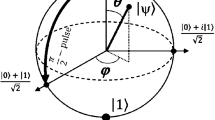Abstract
In our previous work, a new approach to the notorious problem of quantum measurement was proposed. Existing treatments of the problem were incorrect because they ignored the disturbance of measurement by identical particles and standard quantum mechanics had to be modified to obey the cluster separability principle. The key tool was the notion of separation status. Changes of separation status occur during preparations, registrations and scattering on macroscopic targets. Standard quantum mechanics does not provide any correct rules that would govern these changes. This gives us the possibility to add new rules to quantum mechanics that would satisfy the objectification requirement. The method of the present paper is to start from the standard unitary evolution and then introduce minimal corrections. Several representative examples of registration and particle scattering on macroscopic targets are analysed case by case in order to see their common features. The resulting general Rule of Separation Status Changes is stated in the Conclusion.
Similar content being viewed by others
Notes
In our language, a measurement consists of preparation and registration so that what Ref. [6] often calls “measurement” is our “registration”.
Particles have wave functions with three arguments, composite systems containing N particles those with 3N arguments.
It seems that this can be generalised to approximate, ±ϵ say, equality of the average to the expression \(\langle\psi(\vec{x})|\mathsf{A}\psi(\vec{x})\rangle\), leading to generalised separation status denoted by (D,ϵ). The corresponding reformulation of the theory will be published in another paper.
This can easily be generalised to a more realistic condition, e.g., \(\int_{(D'\times )^{K+L}}d^{3}x_{1}\ldots d^{3}x_{K+L}\*T_{\mathsf{J}}(t_{2})(\vec{x}_{1},\ldots,\vec{x}_{K+L};\vec{x}_{1},\ldots,\vec{x}_{K+L})\approx 1\).
References
Hájíček, P., Tolar, J.: Found. Phys. 39, 411 (2009)
Hájíček, P.: Found. Phys. 39, 1072 (2009)
Hájíček, P.: Found. Phys. 41, 640 (2011). arXiv:1001.1827
Hájíček, P., Tolar, J.: Acta Phys. Slovaca 60, 613–716 (2010)
Hájíček, P.: Inst. Phys. Conf. Ser. 306, 012035 (2011)
Busch, P., Lahti, P.J., Mittelstaedt, P.: The Quantum Theory of Measurement. Springer, Heidelberg (1996)
Bassi, A., Ghirardi, G.: Phys. Lett. A 275, 373 (2000)
Wan, K.K., McLean, R.G.D.: J. Phys. A, Math. Gen. 17, 837 (1984)
Kong Wan, K.: From Micro to Macro Quantum Systems. A Unified Formalism with Superselection rules and its Applications. Imperial College Press, London (2006)
Beltrametti, E.G., Cassinelli, G., Lahti, P.J.: J. Math. Phys. 31, 91 (1990)
Leo, W.R.: Techniques for Nuclear and Particle Physics Experiments. Springer, Berlin (1987)
Twerenbold, D.: Rep. Prog. Phys. 59, 239 (1996)
Einstein, A., Podolsky, B., Rosen, N.: Phys. Rev. 47, 777 (1935)
Bohm, D.: Quantum Theory. Prentice Hall, New York (1951), p. 614
Kayser, B., Stodolsky, L.: Phys. Lett. 395, 343 (1995)
Hanbury Brown, R., Twiss, R.Q.: Nature 178, 1046 (1956)
Fano, U.: Am. J. Phys. 29, 536 (1961)
Mott, N.F.: Proc. R. Soc. Lond. Ser. A 126, 79 (1929)
Heisenberg, W.: Physical Principles of the Quantum Theory. Dover, New York (1930)
Dell’Antonio, G., Figari, R., Teta, A.: J. Math. Phys. 49, 042105 (2008)
Davisson, C., Germer, L.: Phys. Rev. 30, 705 (1927)
Mandel, L., Wolf, E.: Optical Coherence and Quantum Optics. Cambridge University Press, Cambridge (1995)
Acknowledgements
The author is indebted to Uwe-Jens Wiese for drawing his attention to the Hanbury Brown and Twiss effect, to an anonymous referee for mentioning the work by K.K. Wan and Jiří Tolar for useful discussions.
Author information
Authors and Affiliations
Corresponding author
Rights and permissions
About this article
Cite this article
Hájíček, P. Changes of Separation Status During Registration and Scattering. Found Phys 42, 555–581 (2012). https://doi.org/10.1007/s10701-012-9626-z
Received:
Accepted:
Published:
Issue Date:
DOI: https://doi.org/10.1007/s10701-012-9626-z




